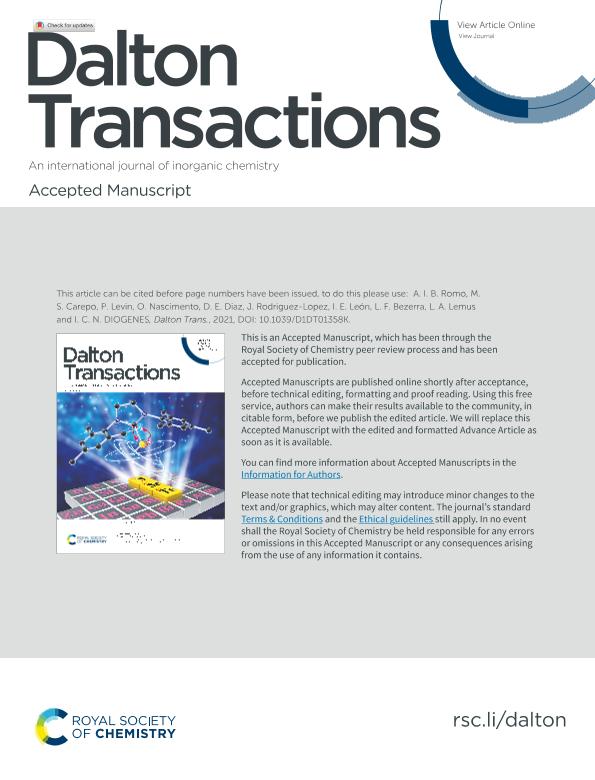Mostrar el registro sencillo del ítem
dc.contributor.author
Romo, Adolfo I. B.
dc.contributor.author
Carepo, Marta P.
dc.contributor.author
Levin, Pedro
dc.contributor.author
Nascimento, Otaciro R.

dc.contributor.author
Díaz, Daniel E.
dc.contributor.author
Rodriguez Lopez, Joaquin
dc.contributor.author
Leon, Ignacio Esteban

dc.contributor.author
Bezerra, Lucas F.
dc.contributor.author
Lemus, Luis A.
dc.contributor.author
Diógenes, Izaura C. N.
dc.date.available
2022-12-14T13:23:31Z
dc.date.issued
2021-07
dc.identifier.citation
Romo, Adolfo I. B.; Carepo, Marta P.; Levin, Pedro; Nascimento, Otaciro R.; Díaz, Daniel E.; et al.; Synergy of DNA intercalation and catalytic activity of a copper complex towards improved polymerase inhibition and cancer cell cytotoxicity; Royal Society of Chemistry; Dalton Transactions; 50; 34; 7-2021; 11931-11940
dc.identifier.issn
1477-9226
dc.identifier.uri
http://hdl.handle.net/11336/181097
dc.description.abstract
Improving the binding of metal complexes to DNA to boost cancer cell cytotoxicity requires fine tuning of their structural and chemical properties. Copper has been used as a metal center in compounds containing intercalating ligands due to its ability to catalytically generate reactive oxygen species (ROS), such as hydroxyl radicals (OH˙). We envision the synergy of DNA binding and ROS generation in proximity to target DNA as a powerful chemotherapy treatment. Here, we explore the use of [Cu(2CP-Bz-SMe)]2+(2CP-Bz-SMe = 1,3-bis(1,10-phenanthrolin-2-yloxy)-N-(4-(methylthio)benzylidene)propan-2-amine) for this purpose by characterizing its cytotoxicity, DNA binding, and ability to affect DNA replication through the polymerase chain reaction - PCR and nuclease assays. We determined the binding (Kb) and Stern-Volmer constants (KSV) for complex-DNA association of 5.8 ± 0.14 × 104and 1.64 (±0.08), respectively, through absorption titration and competitive fluorescence experiments. These values were superior to those of other Cu-complex intercalators. We hypothesize that the distorted trigonal bipyramidal geometry of [Cu(2CP-Bz-SMe)]2+allows the phenanthroline fragments to be better accommodated into the DNA double helix. Moreover, the aromaticity of these fragments increases the local hydrophobicity thus increasing the affinity for the hydrophobic domains of DNA. Nuclease assays in the presence of common reducing agents ascorbic acid, nicotinamide adenine dinucleotide, and glutathione showed the effective degradation of DNA due to thein situgeneration of OH˙. The [Cu(2CP-Bz-SMe)]2+complex showed cytotoxicity against the following human cancer cells lines A549, MCF-7, MDA-MB-231 and MG-63 with half maximal inhibitory concentration (IC50) values of 4.62 ± 0.48, 5.20 ± 0.76, 5.70 ± 0.42 and 2.88 ± 0.66 μM, respectively. These low values of IC50, which are promising if compared to that of cisplatin, are ascribed to the synergistic effect of ROS generation with the intercalation ability into the DNA minor grooves and blocking DNA replication. This study introduces new principles for synergizing the chemical and structural properties of intercalation compounds for improved drug-DNA interactions targeting cancer.
dc.format
application/pdf
dc.language.iso
eng
dc.publisher
Royal Society of Chemistry

dc.rights
info:eu-repo/semantics/openAccess
dc.rights.uri
https://creativecommons.org/licenses/by/2.5/ar/
dc.subject
COBRE
dc.subject
ADN
dc.subject
ROS
dc.subject.classification
Bioquímica y Biología Molecular

dc.subject.classification
Ciencias Biológicas

dc.subject.classification
CIENCIAS NATURALES Y EXACTAS

dc.title
Synergy of DNA intercalation and catalytic activity of a copper complex towards improved polymerase inhibition and cancer cell cytotoxicity
dc.type
info:eu-repo/semantics/article
dc.type
info:ar-repo/semantics/artículo
dc.type
info:eu-repo/semantics/publishedVersion
dc.date.updated
2022-09-21T23:58:54Z
dc.journal.volume
50
dc.journal.number
34
dc.journal.pagination
11931-11940
dc.journal.pais
Reino Unido

dc.journal.ciudad
Cambridge
dc.description.fil
Fil: Romo, Adolfo I. B.. University of Illinois. Urbana - Champaign; Estados Unidos. Universidade Federal do Ceara; Brasil
dc.description.fil
Fil: Carepo, Marta P.. Universidade Nova de Lisboa; Portugal
dc.description.fil
Fil: Levin, Pedro. Universidad de Santiago de Chile; Chile
dc.description.fil
Fil: Nascimento, Otaciro R.. Universidade Federal do São Carlos; Brasil
dc.description.fil
Fil: Díaz, Daniel E.. Universidad de Santiago de Chile; Chile
dc.description.fil
Fil: Rodriguez Lopez, Joaquin. University of Illinois. Urbana - Champaign; Estados Unidos
dc.description.fil
Fil: Leon, Ignacio Esteban. Consejo Nacional de Investigaciones Científicas y Técnicas. Centro Científico Tecnológico Conicet - La Plata. Centro de Química Inorgánica "Dr. Pedro J. Aymonino". Universidad Nacional de La Plata. Facultad de Ciencias Exactas. Centro de Química Inorgánica "Dr. Pedro J. Aymonino"; Argentina
dc.description.fil
Fil: Bezerra, Lucas F.. Universidade Federal do Ceara; Brasil
dc.description.fil
Fil: Lemus, Luis A.. Universidad de Santiago de Chile; Chile
dc.description.fil
Fil: Diógenes, Izaura C. N.. Universidade Federal do Ceara; Brasil
dc.journal.title
Dalton Transactions

dc.relation.alternativeid
info:eu-repo/semantics/altIdentifier/url/http://pubs.rsc.org/en/Content/ArticleLanding/2021/DT/D1DT01358K
dc.relation.alternativeid
info:eu-repo/semantics/altIdentifier/doi/http://dx.doi.org/10.1039/D1DT01358K
Archivos asociados
